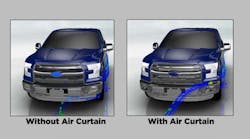For example, consider Ford Motor Co.’s “air curtain technology,” first used on its retooled Mustang sports car and now being applied to its F-150 pickup truck line.
Those “curtains” allow air to flow through a vent underneath the head lamps and out around the wheel, noted Rob Lietz, Ford’s technical expert in applied computational fluid dynamics – ultimately reducing “wind drag” by guiding airflow across the front wheels.
While it’s not obvious to the eye, heThus Lietz and team adopted a new approach to this aerodynamic issue.
Their solution: horizontal slots underneath the head lamps channel air from the front of the truck through ducting to openings in the wheel wells – directing it across the outer surface of the wheel and tire.
“The wall of high-speed air works much like a skirt to reduce drag, while still leaving the alloy wheels fully exposed,” Lietz explained.
Of course, that’s just one little tweak in the F-150’s overall aerodynamic profile, which includes:
- Flush-mounted windshield that eliminates need for molding that would disrupt smooth airflow;
- Tailgate top is designed to act as a spoiler, giving air that flows off the roof a place to land before smoothly trailing off – reducing turbulence behind the truck;
- A cargo box that is narrower than the cab, with no reduction in box volume, which enhances airflow, while a trim piece prevents air from getting trapped between cab and box;
- Rear corners including tail lamps that are precisely angled so air breaks off cleanly – again, helping reduce turbulence behind the truck;
- Placing a duct under each head lamp to channel air through to the wheel-housing and reduces the wake generated from the wheel.
And it’s those tweaks – plus many others – that, when added to more fuel efficient engines, transmissions, and the lighter aluminum body of the 2015 F-150 lineup that translate into greater fuel savings.
Indeed, Ford said Environmental Protection Agency (EPA) fuel economy tests indicate a 2015 4x2 model F-150 equipped with a 2.7-liter EcoBoost V6 engine achieved a fuel economy rating of 19 mpg in city driving and 26 mpg in highway driving for a 22 mpg combined rating.
And this for full-size pickups under 8,500 lbs. GVWR! Certainly not the kinds of fuel numbers you’d expect a pickup truck to attain, though Ford stressed (and rightly so) those numbers vary significantly based on payload, if anything’s being towed, etc.
Still, pretty impressive. Now, if they could work the same aerodynamic fuel saving magic on my minivan …


